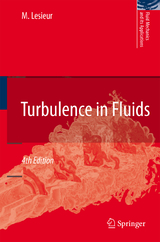
Turbulence in Fluids
Seiten
1997
|
3rd Revised edition
Kluwer Academic Publishers (Verlag)
978-0-7923-4415-5 (ISBN)
Kluwer Academic Publishers (Verlag)
978-0-7923-4415-5 (ISBN)
- Titel erscheint in neuer Auflage
- Artikel merken
Zu diesem Artikel existiert eine Nachauflage
Attempts to reconcile the theory of turbulence, too often presented in a formal, isolated mathematical context, with the general theory of fluid dynamics. This work reviews, in a unifying manner, the main characteristics and general theorems of rotational fluids (liquids or gases), with applications to aerodynamics and geophysical fluid dynamics.
"Turbulence in Fluids" is an attempt to reconcile the theory of turbulence, too often presented in a formal, isolated mathematical context, with the general theory of fluid dynamics. It reviews, in a unifying manner, the main characteristics and general theorems of rotational fluids (liquids or gases), with applications to aerodynamics and geophysical fluid dynamics. Emphasis is placed both on unpredictability, mixing, and coherent vortices or structures. Transition to turbulence in wall or free-shear flows is considered both on the basis of linear-instability theory and of experiments or numerical simulations. Thermal convection is also studied.This third edition presents in a synthetic manner coherent vortices existing both in free or wall-bounded shear flows and in isotropic turbulence. A new mechanics of elementary vortices is built, involving spirals, dipoles, pairings, dislocations, longitudinal hairpins, streaks...It is seen how turbulence topology reacts to the action of stable stratification, rotation, separation or compressibility. The book discusses the phenomenological theories of isotropic turbulence and turbulent diffusion, both in Fourier and physical spaces.
It emphasizes the use of two-point closures and stochastic models, a powerful tool allowing representation of strongly nonlinear actions. The role of helicity is considered. A theory of spectral eddy viscosity and backscatter is proposed. The latter phenomenon is shown to govern inverse cascades of passive scalars and small-scale uncertainty.The Renormalization-Group techniques are assessed. The concept of two-dimensional turbulence is looked at, as the simplest approximation of large-scale atmosphere and ocean dynamics. The latter is also studied using geostrophic-turbulence theory. New ideas on cyclogenesis in thermal fronts are presented. Numerous experimental, environmental and aerodynamic examples are provided. A systematic recourse is made to direct and large-eddy-numerical simulations (LES) as a tool for exploring turbulence media. A complete account of the latest dynamic and selective LES techniques is given in this edition.This monograph is a unique tool for graduate students and researchers in mechanical and aerospace engineering, applied mathematics, physics, meteorology, oceanography and astrophysics.
It views the problem of turbulence in a very general way: statistical theories, intermittency, transition, coherent structures, singularities, unpredictability or deterministic chaos are only small pieces of the same puzzle, which have to be assembled.
"Turbulence in Fluids" is an attempt to reconcile the theory of turbulence, too often presented in a formal, isolated mathematical context, with the general theory of fluid dynamics. It reviews, in a unifying manner, the main characteristics and general theorems of rotational fluids (liquids or gases), with applications to aerodynamics and geophysical fluid dynamics. Emphasis is placed both on unpredictability, mixing, and coherent vortices or structures. Transition to turbulence in wall or free-shear flows is considered both on the basis of linear-instability theory and of experiments or numerical simulations. Thermal convection is also studied.This third edition presents in a synthetic manner coherent vortices existing both in free or wall-bounded shear flows and in isotropic turbulence. A new mechanics of elementary vortices is built, involving spirals, dipoles, pairings, dislocations, longitudinal hairpins, streaks...It is seen how turbulence topology reacts to the action of stable stratification, rotation, separation or compressibility. The book discusses the phenomenological theories of isotropic turbulence and turbulent diffusion, both in Fourier and physical spaces.
It emphasizes the use of two-point closures and stochastic models, a powerful tool allowing representation of strongly nonlinear actions. The role of helicity is considered. A theory of spectral eddy viscosity and backscatter is proposed. The latter phenomenon is shown to govern inverse cascades of passive scalars and small-scale uncertainty.The Renormalization-Group techniques are assessed. The concept of two-dimensional turbulence is looked at, as the simplest approximation of large-scale atmosphere and ocean dynamics. The latter is also studied using geostrophic-turbulence theory. New ideas on cyclogenesis in thermal fronts are presented. Numerous experimental, environmental and aerodynamic examples are provided. A systematic recourse is made to direct and large-eddy-numerical simulations (LES) as a tool for exploring turbulence media. A complete account of the latest dynamic and selective LES techniques is given in this edition.This monograph is a unique tool for graduate students and researchers in mechanical and aerospace engineering, applied mathematics, physics, meteorology, oceanography and astrophysics.
It views the problem of turbulence in a very general way: statistical theories, intermittency, transition, coherent structures, singularities, unpredictability or deterministic chaos are only small pieces of the same puzzle, which have to be assembled.
I. Introduction to Turbulence in Fluid Mechanics. II. Basic Fluid Dynamics. III. Transition to Turbulence. IV. Shear-Flow Turbulence. V. Fourier Analysis of Homogeneous Turbulence. VI. Isotropic Turbulence: Phenomenology and Simulations. VII. Analytical Theories and Stochastic Models. VIII. Two-Dimensional Turbulence. IX. Geostrophic Turbulence. X. Absolute-Equilibrium Ensembles. XI. The Statistical Predictability Theory. XII. Large-Eddy Simulations. XIII. Towards Real-World Turbulence.
| Reihe/Serie | Fluid Mechanics and its Applications ; v. 40 |
|---|---|
| Zusatzinfo | references, index |
| Sprache | englisch |
| Einbandart | gebunden |
| Themenwelt | Naturwissenschaften ► Physik / Astronomie |
| Technik ► Maschinenbau | |
| ISBN-10 | 0-7923-4415-4 / 0792344154 |
| ISBN-13 | 978-0-7923-4415-5 / 9780792344155 |
| Zustand | Neuware |
| Informationen gemäß Produktsicherheitsverordnung (GPSR) | |
| Haben Sie eine Frage zum Produkt? |
Mehr entdecken
aus dem Bereich
aus dem Bereich
Eine Einführung in die Allgemeine Relativitätstheorie
Buch | Softcover (2023)
De Gruyter Oldenbourg (Verlag)
CHF 89,95
Problem Solving with Python
Buch | Softcover (2024)
Wiley-VCH (Verlag)
CHF 149,95



